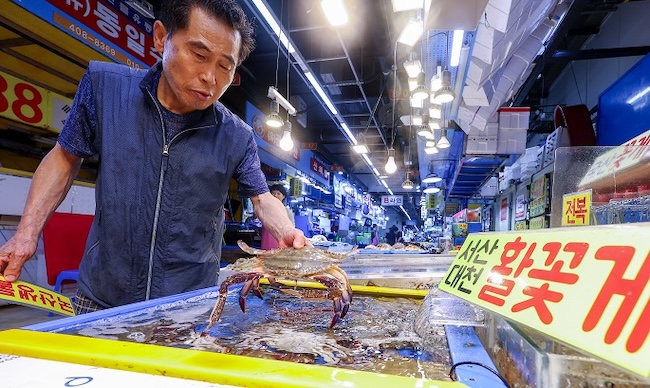
Major retailers report that imported seafood now accounts for up to 70% of their seafood sales. (Image courtesy of Yonhap)
SEOUL, Oct. 29 (Korea Bizwire) – Rising sea temperatures and climate change are transforming South Korea’s seafood consumption patterns, with imported seafood increasingly replacing domestic catches on dinner tables as local fish populations decline.
Major retailers report that imported seafood now accounts for up to 70% of their seafood sales, as consumers turn to more affordable foreign alternatives like Norwegian and Chilean salmon, Falkland Islands squid, and Vietnamese shrimp instead of pricier domestic products.
According to E-mart, South Korea’s largest retailer, imported seafood (excluding dried seafood) exceeded 50% of total seafood sales for the first time this year. The share has steadily increased from 45% in 2021 to 46% in 2022, 48% in 2023, and 51% in the first nine months of 2024.
Lotte Mart reported even higher figures, with imported seafood accounting for 70% of sales, up from 65% in 2021. Home Plus has seen its import share rise from 46% in 2021 to 48% this year.
The shift comes as warming waters have severely impacted domestic fishing. Pacific cod, once known as Korea’s “national fish” and a staple of the East Sea, has virtually disappeared since the 2000s due to overfishing and rising water temperatures, leading to a complete ban on domestic catches in 2019.
Squid catches have plummeted as El Niño has pushed East Sea temperatures above the 15-23°C range optimal for spawning. The warm water phenomenon has also affected catches of flounder, monkfish, and sand lance, forcing fishing operations to move northward.
Even this fall’s typically abundant Pacific herring season saw such reduced catches that Lotte Mart didn’t sell fresh herring for the first time in 10 years, while E-mart and Home Plus halved their supply compared to last year.
The changing market dynamics are reflected in individual product sales. At E-mart, imported mackerel accounted for 58% of all mackerel sales through last month, while imported and deep-sea squid made up 45.9% of squid sales.
Home Plus has begun selling Chinese dried squid, Vietnamese semi-dried squid, and Brazilian octopus for the first time this year. The retailer’s top-selling seafood item has been salmon since 2021, replacing squid which held the top spot in 2020.
“While Koreans traditionally favored seasonal domestic fish like spring flounder and fall herring, consumption patterns are now centered around globally traded items like Norwegian salmon and Russian king crab,” said a retail industry representative. “Climate change is fundamentally altering Korean dining tables.”
At E-mart, salmon has consistently ranked as the top-selling seafood item since 2021, with Norwegian salmon accounting for 90% of sales and Chilean salmon making up the remainder. The fish’s versatility for sashimi, grilling, and as frozen smoked products has driven its popularity.
Lotte Mart reported that squid remains its top-selling seafood item, with domestic catches accounting for 75% of sales and Falkland Islands catches making up the remaining 25%.
The range of imported seafood has diversified to include Pacific saury from Taiwan and hairtail from Oman, among others, as retailers seek to offer more affordable alternatives to increasingly expensive domestic seafood.
Lina Jang (linajang@koreabizwire.com)






